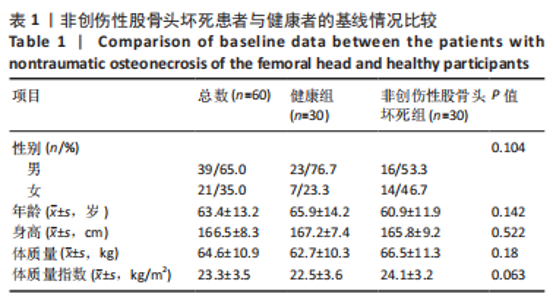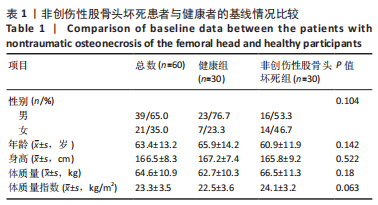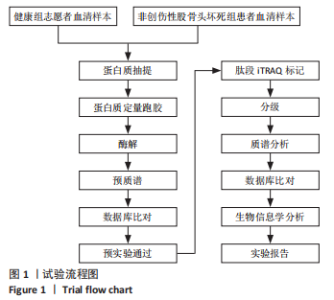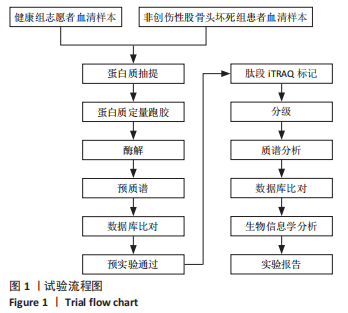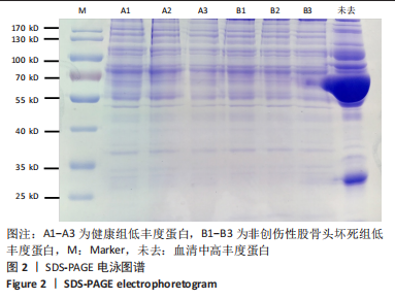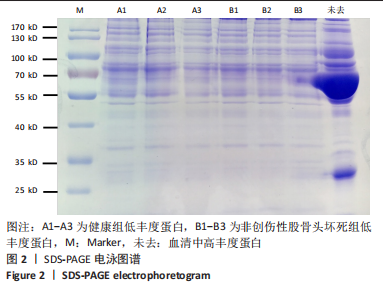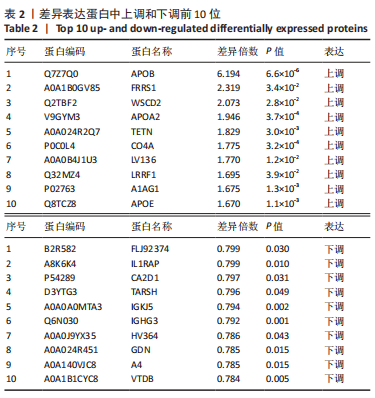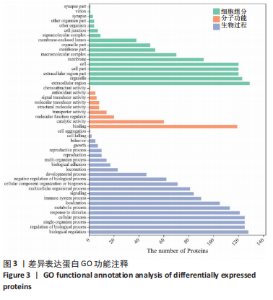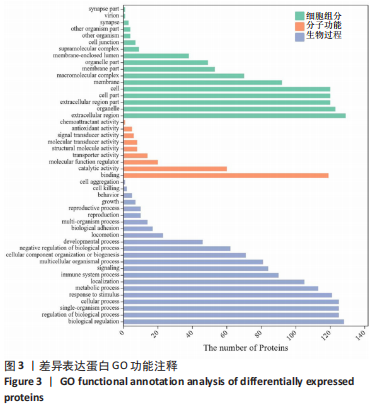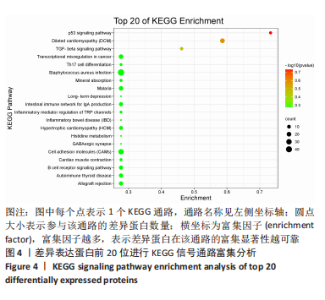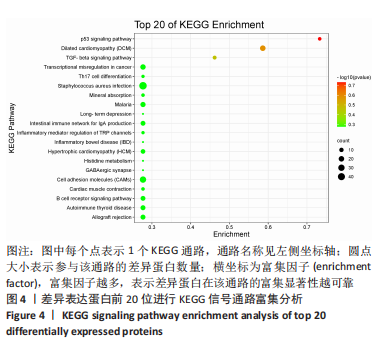[1] MOGHAMIS I, ALHAMMOUD AA, KOKASH O, et al. The outcome of hyperbaric oxygen therapy versus core decompression in the non-traumatic avascular necrosis of the femoral head: Retrospective Cohort Study. Ann Med Surg (Lond). 2021;62:450-454.
[2] KURODA Y, OKUZU Y, KAWAI T, et al. Difference in Therapeutic Strategies for Joint-Preserving Surgery for Non-Traumatic Osteonecrosis of the Femoral Head between the United States and Japan: A Review of the Literature. Orthop Surg. 2021;13(3):742-748.
[3] PENG Y, LIU Y, HUANG D, et al. Association of TNF-α-308(G/A) and -238(G/A) polymorphisms with non-traumatic osteonecrosis of the femoral head risks: a meta-analysis. Int Orthop. 2018;42(7):1711-1721.
[4] 钱晓芬,曾平,刘金富,等.酒精性股骨头坏死竞争性内源RNA网络及潜在生物标志物的综合分析[J].中国组织工程研究,2022, 26(23):3670-3675.
[5] PASCART T, FALGAYRAC G, MIGAUD H, et al. Region specific Raman spectroscopy analysis of the femoral head reveals that trabecular bone is unlikely to contribute to non-traumatic osteonecrosis. Sci Rep. 2017;7(1):97.
[6] 张恩景,廖文,蔡进奎,等.非创伤性股骨头坏死的基因多态性研究进展[J].中国骨质疏松杂志,2018,24(4):543-546,551.
[7] MONT MA, CHERIAN JJ, SIERRA RJ, et al. Nontraumatic Osteonecrosis of the Femoral Head: Where Do We Stand Today? A Ten-Year Update. J Bone Joint Surg Am. 2015;97(19):1604-1627.
[8] WANG J, GAO L, LEE YM, et al. Target identification of natural and traditional medicines with quantitative chemical proteomics approaches. Pharmacol Ther. 2016;162:10-22.
[9] AGGARWAL S, YADAV AK. Dissecting the iTRAQ Data Analysis. Methods Mol Biol. 2016;1362:277-291.
[10] FENG Y, HE Y, WANG J, et al. Application of iTRAQ proteomics in identification of the differentially expressed proteins of placenta of pregnancy with preeclampsia. J Cell Biochem. 2019;120(4):5409-5416.
[11] 中国医师协会骨科医师分会显微修复工作委员会,中国修复重建外科专业委员会骨缺损及骨坏死学组.成人股骨头坏死临床诊疗指南(2016)[J].中华骨科杂志,2016,36(15):945-954.
[12] 中国医师协会骨科医师分会骨循环与骨坏死专业委员会,中华医学会骨科分会骨显微修复学组,国际骨循环学会中国区.中国成人股骨头坏死临床诊疗指南(2020)[J].中华骨科杂志,2020,40(20): 1365-1376.
[13] JIANG X, ARREY T, DAMOC E, et al. Q Exactive 系列仪器中 TMT 定量工作流程的仪器参数优化和 Proteome Discoverer 2.1软件数据处理方法. http://www.thermoscientific.cn/content/dam/tfs/Country%20Specific%20Assets/zh-ch/CMD/MS/LCMS/ documents/TMT-Workflow-Q-Exactive.pdf[2022-08-09]
[14] FUKUSHIMA W, FUJIOKA M, KUBO T, et al. Nationwide epidemiologic survey of idiopathic osteonecrosis of the femoral head. Clin Orthop Relat Res. 2010;468(10):2715-2724.
[15] MAUREL DB, JAFFRE C, ROCHEFORT GY, et al. Low bone accrual is associated with osteocyte apoptosis in alcohol-induced osteopenia. Bone. 2011;49(3):543-552.
[16] FUKUSHIMA W, YAMAMOTO T, TAKAHASHI S, et al. The effect of alcohol intake and the use of oral corticosteroids on the risk of idiopathic osteonecrosis of the femoral head: a case-control study in Japan. Bone Joint J. 2013;95-B(3):320-325.
[17] OKAZAKI S, NAGOYA S, TATEDA K, et al. Experimental rat model for alcohol-induced osteonecrosis of the femoral head. Int J Exp Pathol. 2013;94(5):312-319.
[18] YOON BH, KIM TY, SHIN IS, et al. Alcohol intake and the risk of osteonecrosis of the femoral head in Japanese populations: a dose-response meta-analysis of case-control studies. Clin Rheumatol. 2017; 36(11):2517-2524.
[19] KUBO T, UESHIMA K, SAITO M, et al. Clinical and basic research on steroid-induced osteonecrosis of the femoral head in Japan. J Orthop Sci. 2016;21(4):407-413.
[20] LIU LH, ZHANG QY, SUN W, et al. Corticosteroid-induced Osteonecrosis of the Femoral Head: Detection, Diagnosis, and Treatment in Earlier Stages. Chin Med J (Engl). 2017;130(21):2601-2607.
[21] WU B, DONG Z, LI S, et al. Steroid-induced ischemic bone necrosis of femoral head: Treatment strategies. Pak J Med Sci. 2015;31(2): 471-476.
[22] 张聪敏,任凯迪,张绮雯,等.激素性股骨头坏死易感基因的研究进展[J].中国药学杂志,2022,57(2):85-89.
[23] YANG J, JING M, YANG X. Association between genetic polymorphisms and osteonecrosis in steroid treatment populations: a detailed stratified and dose-response meta-analysis. Biosci Rep. 2019;39(5): BSR20190024.
[24] FAN R, LIU K, ZHOU Z. Abnormal Lipid Profile in Fast-Growing Broilers With Spontaneous Femoral Head Necrosis. Front Physiol. 2021;12: 685968.
[25] LIU K, WANG K, WANG L, et al. Changes of lipid and bone metabolism in broilers with spontaneous femoral head necrosis. Poult Sci. 2021; 100(3):100808.
[26] 陈卫衡,林娜,郭效东,等.非创伤性股骨头坏死与血浆脂蛋白的相关性研究[J].中国骨伤,2003,16(2):69-70.
[27] HIRATA T, FUJIOKA M, TAKAHASHI KA, et al. ApoB C7623T polymorphism predicts risk for steroid-induced osteonecrosis of the femoral head after renal transplantation. J Orthop Sci. 2007;12(3):199-206.
[28] HIRATA T, FUJIOKA M, TAKAHASHI KA, et al. Low molecular weight phenotype of Apo(a) is a risk factor of corticosteroid-induced osteonecrosis of the femoral head after renal transplant. J Rheumatol. 2007;34(3):516-522.
[29] NIGOLIAN H, RIBI C, COURVOISIER DS, et al. Anti-apolipoprotein A-1 autoantibodies correlate with disease activity in systemic lupus erythematosus. Rheumatology (Oxford). 2020;59(3):534-544.
[30] GU J, ZHANG S, CHEN L, et al. Performing a Safe and Effective Total Hip Arthroplasty on Patients With Inactive or Stably Active Systemic Lupus Erythematosus With Osteonecrosis. J Am Acad Orthop Surg. 2021;29(10):423-432.
[31] 袁兆丰,高润子,张长昊,等.基于候选基因关联分析的非创伤性股骨头坏死基因组学研究进展[J].中国中医骨伤科杂志,2022, 30(2):81-84.
[32] YUAN L, LI W, WANG X, et al. The relationship between genetic polymorphisms in apolipoprotein E (ApoE) gene and osteonecrosis of the femoral head induced by steroid in Chinese Han population. Genes Genomics. 2018;40(2):225-231.
[33] SUN F, ZHOU JL, LIU ZL, et al.Dexamethasone induces ferroptosis via P53/SLC7A11/GPX4 pathway in glucocorticoid-induced osteonecrosis of the femoral head. Biochem Biophys Res Commun. 2022;602:149-155.
[34] ZUO W, GUO WS, YU HC, et al. Role of Junction-Mediating and Regulatory Protein in the Pathogenesis of Glucocorticoid-Induced Endothelial Cell Lesions. Orthop Surg. 2020;12(3):964-973.
[35] ZHANG F, PENG W, ZHANG J, et al. P53 and Parkin co-regulate mitophagy in bone marrow mesenchymal stem cells to promote the repair of early steroid-induced osteonecrosis of the femoral head. Cell Death Dis. 2020;11(1):42.
[36] MEN H, CAI H, CHENG Q, et al. The regulatory roles of p53 in cardiovascular health and disease. Cell Mol Life Sci. 2021;78(5):2001-2018.
[37] 许灿宏,陈跃平,章晓云.成骨信号通路在非创伤性股骨头坏死中的作用[J].中国组织工程研究,2020,24(14):2235-2242.
[38] ZHANG YE. Mechanistic insight into contextual TGF-β signaling. Curr Opin Cell Biol. 2018;51:1-7.
[39] TAO J, DONG B, YANG LX, et al. TGF‑β1 expression in adults with non‑traumatic osteonecrosis of the femoral head. Mol Med Rep. 2017; 16(6):9539-9544.
[40] WU M, CHEN G, LI YP. TGF-β and BMP signaling in osteoblast, skeletal development, and bone formation, homeostasis and disease. Bone Res. 2016;4:16009.
[41] BAI Y, LIU Y, JIN S, et al. Expression of microRNA‑27a in a rat model of osteonecrosis of the femoral head and its association with TGF‑β/Smad7 signalling in osteoblasts. Int J Mol Med. 2019;43(2):850-860.
[42] CHEN D, ZHANG G, LI Y, et al. Up-regulation of urinary exosomal hsa-microRNA-200b-3p and hsa-microRNA-206 in patients of steroid-induced osteonecrosis of femoral head. Am J Transl Res. 2021;13(7): 7574-7590.
[43] HAN N, QIAN F, NIU X, et al. Circ_0058792 regulates osteogenic differentiation through miR-181a-5p/Smad7 axis in steroid-induced osteonecrosis of the femoral head. Bioengineered. 2022;13(5): 12807-12822.
[44] FANG SH, CHEN L, CHEN HH, et al. MiR-15b ameliorates SONFH by targeting Smad7 and inhibiting osteogenic differentiation of BMSCs. Eur Rev Med Pharmacol Sci. 2019;23(22):9761-9771.
|
